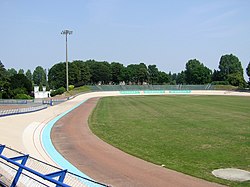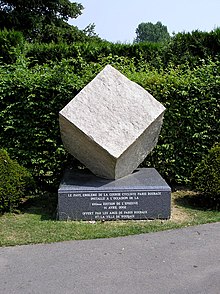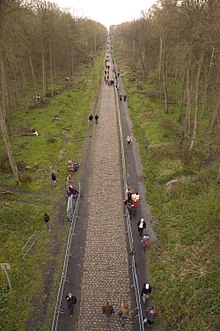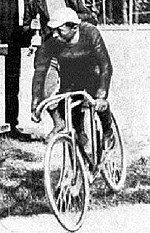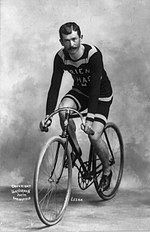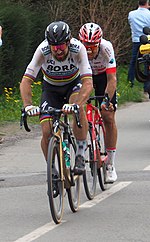Paris-Roubaix
The Paris-Roubaix (also known as "The Hell of the North" or "The Classic of the Classics") is a one-day professional road cycling race held in the area northern France. It covers a route from Compiègne, a city near the Paris region, to the Roubaix velodrome, in the Haute-France region, hence its name. It is frequently held on the second Sunday of April, one week after the Tour of Flanders, and belongs to the UCI WorldTour calendar, the highest category of professional racing.
Considered one of the toughest cycling events in the world, Paris-Roubaix was first held in 1896, making it one of the oldest races still on the international calendar. Since its creation, the race has been interrupted three times, two of them due to the first (1915 to 1918) and second world wars (1940 to 1942) and the third in 2020 due to the COVID-19 pandemic.
It is the third of the so-called "cycling monuments" (Milan-San Remo, Tour of Flanders, Liège-Bastogne-Liège and Giro de Lombardy) and is the second and last pavé monument of the season. It is also the last cobbled section classic on the UCI WorldTour calendar and is part of the so-called "Classics of Flanders".
Apart from its long mileage (approx. 260 km), it is characterized by its 50 km of pavé, great incentive and difficulty of the race, which are distributed in sectors between the last two thirds of the route.
With four victories, two cyclists hold the record for victories in the event: the Belgian Roger De Vlaeminck (1972, 1974, 1975 and 1977) and Tom Boonen (2005, 2008, 2009 and 2012).
It is organized by the Amaury Sport Organization (ASO) and since 1967 and 2003 the race has had an under-23 and junior version. In 2020, and at the same time that the new dates of the UCI calendar were announced, during the COVID-19 crisis, the event was announced in the female modality for the first time since its creation, however both events that would be held at the end of October they were definitively canceled due to the declaration of a state of maximum alert due to the increase in cases of COVID-19.
History
Birth and first edition
The creation of Paris-Roubaix was promoted by the sports newspaper Le vélo. Its director Paul Rousseau received the idea from two businessmen from the town of Roubaix, Théo Vienne and Maurice Perez, who saw in this race a good training for the then most famous Bordeaux-Paris and, after supervising the layout of the test, launched the competition under the name of La Pascale.
That first edition left on April 19 from the Bois de Boulogne, north of Paris, to cover the more than 300 kilometers that separated it from Roubaix. Its first winner was the German Josef Fischer and the prize he received was 1000 French francs.
Evolution and journey
Since then, the test has only stopped taking place on 7 occasions, all motivated by the two World Wars, from 1915 to 1918 and from 1940 to 1942. Until 1966 it continued leaving Paris but that year its place of departure was changed to the town of Chantilly, 50 kilometers north of Paris. Later, in 1977, it was changed again, this time to Compiègne. As a curiosity, note that in the 2007 Tour de France, the Swiss cyclist Fabian Cancellara, winner of the Paris-Roubaix in 2006, achieved stage victory in Compiègne after attacking on the cobbled section that was located just one kilometer from the goal.
It was part of the Cycling World Cup from its launch in 1989, until its disappearance after the 2004 season.
What makes the Paris-Roubaix a unique race is the extreme hardness of the terrain on which it is contested, the pavés. Despite the fact that there are other tests that take place on cobbled sections, none of them accumulates so many kilometers on this type of surface, always around 50 kilometers depending on the route. These sections, about 30, which follow each other more or less from kilometer 100 of the test to the town of Roubaix itself, can reach around 4 kilometers and are rated with stars, with those of 5 stars being considered the toughest.. This categorization is established based on the layout of the section, its distance and the state of the pavés. Among the best known is the Arenberg Forest and the Carrefour de l'Arbre, both, next to the Mons-en-Pévèle section, the only ones qualified with the aforementioned 5 stars.
Other particularities of this race are its place of completion and the trophy that is awarded to the winner. Since its first edition, the Paris - Roubaix finishes at the Roubaix velodrome. The participants, after passing the finish line, still have to complete a complete turn around the ring to finish the test. When the victor steps onto the podium, the trophy he receives is a replica of the thousands of cobblestones he has traversed to get there. Since the celebration of the 100th edition, there is a monument, a reproduction of the one given to the winners, in the town of Roubaix.
Mud and falls
But if there is a symbolic image of the extreme hardness and uniqueness of this race, it is the muddy faces of the runners. Due to the dates on which it takes place, the second Sunday of April, a week just after the Tour of Flanders, it is usual that, if it does not rain during the course of the race, at least it did in the preceding hours or days. This fact, together with the fact that dust and sand are much more abundant in the cobblestone sections than on a paved road, means that many kilometers run through real mud. This peculiarity, together with the narrowness of the pavé sections and the difficulty involved in driving through them, are the main cause of the numerous falls that take place every year. And this peculiarity was what led a runner like Sean Kelly to affirm that "a Paris-Roubaix without rain is not a true Paris-Roubaix".
As a curiosity, note that the nickname "the hell of the north" It is not originally related to the hardness of the test but to the state in which the route was left after the conclusion of the First World War. Then, a reporter wrote in his newspaper that the runners had gone through "the hell of the north".
Main difficulties
Paris-Roubaix sub-23
Since 1967, the Paris-Roubaix sub-23 (officially: Paris-Roubaix Espoirs), which is a Paris- Roubaix limited to under-23 riders, which takes place at the end of May.
Its first editions were amateur until the creation of the UCI Continental Circuits in 2005 as part of the UCI Europe Tour, the first two years in category 1.2 (last category of professionalism) and later in the specific category created in 2007 for riders sub-23, also within the last category of professionalism: 2.1U.
It has about 180 km in its layout, about 80 km less than its namesake without age limitation, although with similar characteristics.
Unlike its namesake without age limitation, it has not been organized by ASO (also organizer of the Tour de France among others). Starting in 2011, the organizers, VC Roubaix, announced that they would stop organizing the race due to the high costs of security. A week later, ASO came to the rescue of the test and took over it.
Paris-Roubaix juniors
There is also the Paris-Roubaix juniors, for cyclists aged 17 and 18. It runs in April, the same day as Paris-Roubaix and was created in 2003.
Honours of Prizes
Note: In the 1949 edition there were two winners: André Mahé was the first runner to cross the finish line, but he did so after race officials made a mistake and made entering the velodrome the group that was running away from the wrong place. They even had to enter the Roubaix Velodrome jumping with the bicycle through the stands. Serse Coppi, brother of the famous Fausto Coppi, was the first cyclist to cross the finish line, entering the velodrome from the right place. After a great controversy it was decided to name the two winning cyclists of that edition.
The second position obtained by George Hincapie in the Paris Roubaix 2006, was declared void after the suspension given by the UCI to the cyclist in the framework of the doping case against Lance Armstrong
Human awards by country
- ↑ In 1949 there were two winners and the 2nd position was deserted.
Statistics
Most wins
Consecutive wins
- Two victories in a row:
Faster edits
- 45.8 km/h
 Dylan van Baarle 2022, 257.2 km)
Dylan van Baarle 2022, 257.2 km) - 45,204 km/h (
 Greg Van Avermaet 2017, 257 km)
Greg Van Avermaet 2017, 257 km) - 45.129 km/h (
 Peter Post 1964, 265 km)
Peter Post 1964, 265 km) - 44.190 km/h (
 Fabian Cancellara 2013, 254,5 km)
Fabian Cancellara 2013, 254,5 km) - 43,612 km/h (
 Rik Van Steenbergen 1948, 246 km)
Rik Van Steenbergen 1948, 246 km) - 43,538 km/h (
 Pino Cerami 1960, 262 km)
Pino Cerami 1960, 262 km) - 43,522 km/h (
 Germain Derijcke 1953, 245 km)
Germain Derijcke 1953, 245 km) - 43,476 km/h (
 Tom Boonen 2012, 257.7 km)
Tom Boonen 2012, 257.7 km) - 43,475 km/h (
 John Degenkolb 2015, 253.5 km)
John Degenkolb 2015, 253.5 km) - 43,406 km/h (
 Tom Boonen 2008, 259,5 km)
Tom Boonen 2008, 259,5 km) - 43,305 km/h (
 Johan Museeuw 1996, 262 km)
Johan Museeuw 1996, 262 km) - 43,105 km/h (
 Francesco Moser 1980, 264 km)
Francesco Moser 1980, 264 km)
More podiums
Roger De Vlaeminck is the cyclist with the most podium finishes in the race.
Until the 2018 edition.
Contenido relacionado
Cyclassics Hamburg
South American Football Confederation
Fishing rod
